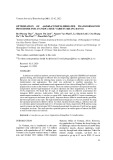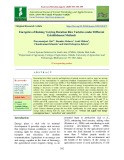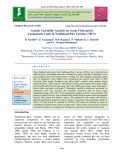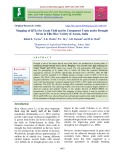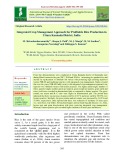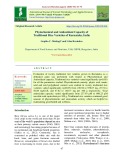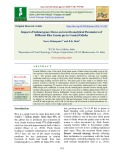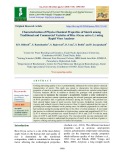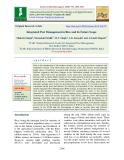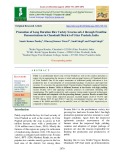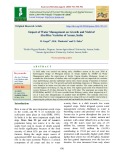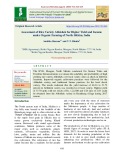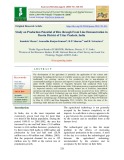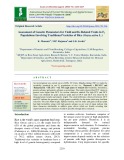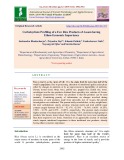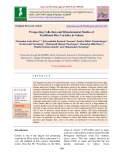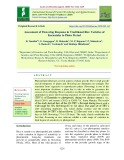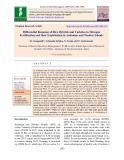
Traditional rice varieties
-
In addition to traditional methods, advanced biotechnologies, especially CRISPR/Cas9-mediated genome editing, have emerged as effective tools for improving important agronomic traits in rice. However, the critical step for utilizing these systems is to develope an effective system for rice transformation and regeneration.
 11p
11p  vimulcahy
vimulcahy
 18-09-2023
18-09-2023
 4
4
 3
3
 Download
Download
-
Increasing farm labor scarcity and depletion of natural resources such as water are posing threats to the sustainability of traditional Puddled Transplanted Rice (PTR) system in Eastern India. Dry-seeded rice (DSR) or Non-Puddled Transplanted Rice (NPTR) could be used as an alternative to PTR.
 8p
8p  trinhthamhodang1216
trinhthamhodang1216
 19-11-2020
19-11-2020
 11
11
 2
2
 Download
Download
-
Three hundred and twenty four Traditional Rice Varieties (TRVs) were collected from different parts of Karnataka and were evaluated for grain yield and its attributes in two seasons (kharif 2011 and summer 2012) at ZARS, VC Farm, Mandya, Karnataka, India.
 9p
9p  nguathienthan8
nguathienthan8
 20-10-2020
20-10-2020
 20
20
 2
2
 Download
Download
-
Drought is one of the major abiotic stress that limits rice production in Assam, India. A traditional drought tolerant local cultivar ‘Banglami’ was crossed with a high yielding rice variety ‘Ranjit’ and 180 F2 plants were raised. The 110 polymorphic SSR markers were used for genotyping of F2 plants.
 13p
13p  trinhthamhodang1215
trinhthamhodang1215
 23-09-2020
23-09-2020
 9
9
 2
2
 Download
Download
-
Integrated crop management approach for profitable rice production in Uttara Kannada district, India
Front line demonstrations were conducted in Uttara Kannada district of Karnataka state during Kharif season in the year 2017, 2018 and 2019 to increasing rice productivity and income by replacement of Abhilash old variety with promising high yielding improved variety PSB-68 and traditional practice with integrated crop management. Study revealed that over the years, PSB-68 Paddy variety with integrated crop management approach was superior over Abhilash variety with farmer practices...
 12p
12p  caygaocaolon7
caygaocaolon7
 18-09-2020
18-09-2020
 17
17
 0
0
 Download
Download
-
Evaluation of twenty traditional rice varieties grown in Karnataka, as a dehusked grain was performed with respect to Phytochemical and Antioxidant capacity.
 9p
9p  caygaocaolon6
caygaocaolon6
 30-07-2020
30-07-2020
 9
9
 1
1
 Download
Download
-
Coastal Odisha is one of the most flood prone areas of India where the paddy crop in the wet season is often devastated by flash floods with an average productivity of only 0.5–0.8 t ha⁻ ¹. The present study showed that farmers preferred to cultivate low yielding traditional land races owing to their better flood tolerance and the unavailability of flood tolerant high yielding varieties (HYVs).
 10p
10p  nguathienthan5
nguathienthan5
 04-06-2020
04-06-2020
 16
16
 1
1
 Download
Download
-
Cooking and eating quality of rice is predominantly influenced by various physio-chemical characteristics of starch. This study was aimed to characterize the physio-chemical properties of starch in commercially and traditionally cultivated rice varieties using Rapid Viscosity Analyser (RVA) in relation to identify the genotype with prominent starch composition to maximize the consumer’s acceptability.
 14p
14p  nguathienthan5
nguathienthan5
 04-06-2020
04-06-2020
 10
10
 1
1
 Download
Download
-
Prior to the introduction of the modern varieties, the rice crop survived for centuries with traditional varieties with robust plant type but low yield. The farmers started applying higher doses of fertilizers in general and nitrogen in particular as these varieties were fertilizer responsive and these changes in rice cultivation resulted in an altered microclimate, which led to the accentuation of the insect pest and disease problems. Many diseases such as sheath blight, sheath rot, false smut and leaf scald have become severe in several parts of the country.
 8p
8p  chauchaungayxua5
chauchaungayxua5
 08-05-2020
08-05-2020
 12
12
 0
0
 Download
Download
-
Paddy is a predominant kharif crop of Uttar Pradesh as well as the country and plays a major role in augmenting the income of small and marginal farmers of Chandauli district of Uttar Pradesh. One of the major constraints of traditional paddy cultivation is low productivity due to non-adoption of recommended package of practices and improved varieties.
 5p
5p  kequaidan4
kequaidan4
 05-05-2020
05-05-2020
 11
11
 1
1
 Download
Download
-
A field study was carried out during early Ahu/Boro season in the year 2016 at Konwargaon village of Morigaon district of Assam funded by AICRP on Water Management under the supervision of Krishi Vigyan Kendra, Morigaon, Assam to evaluate the effectiveness of shallow tube well irrigation with two improved rice varieties (Luit and Dishang) and one traditional variety (Soru Guni) among 15 numbers of farmers covering an area of 2 ha.
 6p
6p  angicungduoc4
angicungduoc4
 26-04-2020
26-04-2020
 10
10
 0
0
 Download
Download
-
The KVK, Mangan, North Sikkim conducted On Station Trials and Frontline Demonstrations to evaluate the suitability and profitability of high yielding rice variety Abhishek over local variety Attey as check in different locations. Improved organic cultivation practices were followed for the Abhishek variety and traditional farmer practices for the local check variety. The results indicated that the yield increase of 46.34 to 51.72 percent in Abhishek variety was recorded over local variety. Highest yield of 37.70 qt/ha with net return of Rs. 1,22,500 and C:B ratio of 2.
 6p
6p  trinhthamhodang1212
trinhthamhodang1212
 06-04-2020
06-04-2020
 10
10
 1
1
 Download
Download
-
The development of the agriculture is primarily the application of the science and technology by making the best use of available resources; one of the major constraints of traditionally rice growing varieties is low productivity due to non-adoption of recommended package of practices and improves varieties. Krishi Vigyan Kendra, Deoria under ICAR- Indian Institute of Vegetable Research had conducted Front Line Demonstration (FLD) in adopted farmer fields.
 4p
4p  trinhthamhodang4
trinhthamhodang4
 22-03-2020
22-03-2020
 14
14
 1
1
 Download
Download
-
An investigation was carried out at ZARS, VC Farm, Mandya during 2015 to study the variability produced in two F2 populations of rice viz., ‘Rajamudi × BR-2655’ and ‘Rathnachoodi × BR-2655’ with 500 single plants to estimate the variability, heritability, genetic advance and genetic advance as percentage. The results showed that PCV values in general were higher than GCV for various characters studied. The high PCV and GCV values was obtained for grain yield per plant and low PCV and GCV was observed for thousand grain weight and panicle length.
 8p
8p  trinhthamhodang4
trinhthamhodang4
 22-03-2020
22-03-2020
 19
19
 1
1
 Download
Download
-
Rice is known as the ‘grain of life’. It is the staple food for more than half of the world’s population. Due to processing, alteration of nutritional quality takes place either by changes in nutrients or by an improvement in digestibility of nutrients. Hurum, komal chaul, bhoja bora, puffed rice, popped rice, flaked rice, korai, sandahguri are the rice products obtained from specialty rice varieties of Assam. A unique characteristic of these rice products is that the products can be used instantly.
 11p
11p  trinhthamhodang4
trinhthamhodang4
 22-03-2020
22-03-2020
 7
7
 0
0
 Download
Download
-
The diagnosis of places of varietal diversity of rice in Guinea was made from survey data from several farms in 41 villages themselves distributed in the 2 natural regions of Lower Guinea and Forest Guinea. The descriptors used are the number of known varieties and varieties cultivated at different scales, as well as their utilization rate. The latter makes it possible to classify the Sativa and Glaberrima varieties at the village level and to identify improved and local varieties of notoriety.
 17p
17p  nguaconbaynhay4
nguaconbaynhay4
 22-03-2020
22-03-2020
 7
7
 1
1
 Download
Download
-
Photoperiod influences several aspects of plant growth. The overall growth and development of plants and flowering are dependent on sunlight. The transition from vegetative to reproductive phase (flowering) is one of the most important decisions a plant has to take in order to guarantee the success of its offspring.
 6p
6p  chauchaungayxua4
chauchaungayxua4
 18-03-2020
18-03-2020
 8
8
 1
1
 Download
Download
-
With the advent of the Green revolution high yielding varieties had their upper hand and the medicinal properties of landraces and the traditional rice varieties became an ignored experience. Traditional rice varieties are a consortium of desirable traits such as high yielding, tolerance to extreme stress conditions and also are rich in nutritive and therapeutic value. They have reduced sugar content and are preferred by people who are trying to regulate their sugar intake or suffering from diabetics, overweight. They are rich in vitamins, fibre and glutamic acid.
 6p
6p  caygaocaolon2
caygaocaolon2
 14-03-2020
14-03-2020
 9
9
 1
1
 Download
Download
-
Bhagalpur district of Bihar has been a traditional aromatic rice growing area, where the varieties, like Katarni, Tulsi Manjari, Badshahbhog, Br-9 and Br-10 are most common. This variety has been given Geographical Indication (GI) due to its unique and special quality trait which develops only in its GI territory area. Despite its uniqueness katarni rice is facing the threat of extinction, mainly due to declining irrigation facility, adoption of other high yielding rice varieties and adulteration by traders of non- aromatic rice grains with katarni with the profit motto.
 7p
7p  caygaocaolon2
caygaocaolon2
 11-03-2020
11-03-2020
 6
6
 0
0
 Download
Download
-
In Andaman and Nicobar Islands, India, rice productivity is low due to traditional long duration variety (C-14-8) cultivation on poorly fertile soils with minimal or no fertilizer use due to heavy rains. In this context, ability of rice hybrids and high yielding varieties (HYV) under varying nitrogen supplies to adopt and enhance rice productivity and profits. Field study was made during 2015 rainy season in split plot design with three replications.
 15p
15p  caygaocaolon3
caygaocaolon3
 09-03-2020
09-03-2020
 14
14
 1
1
 Download
Download
CHỦ ĐỀ BẠN MUỐN TÌM









